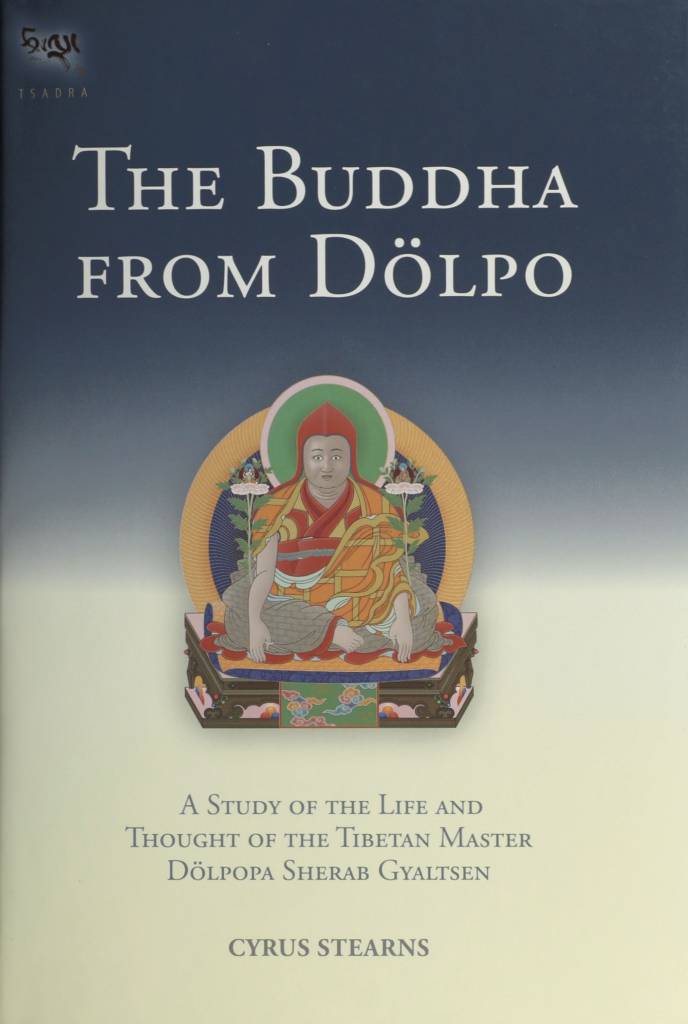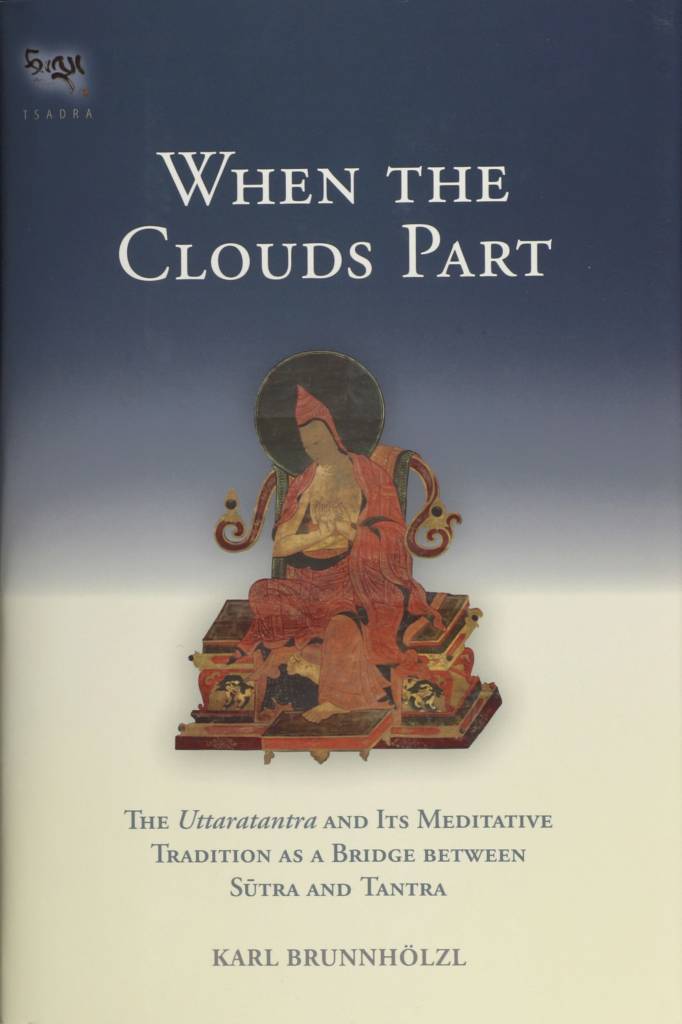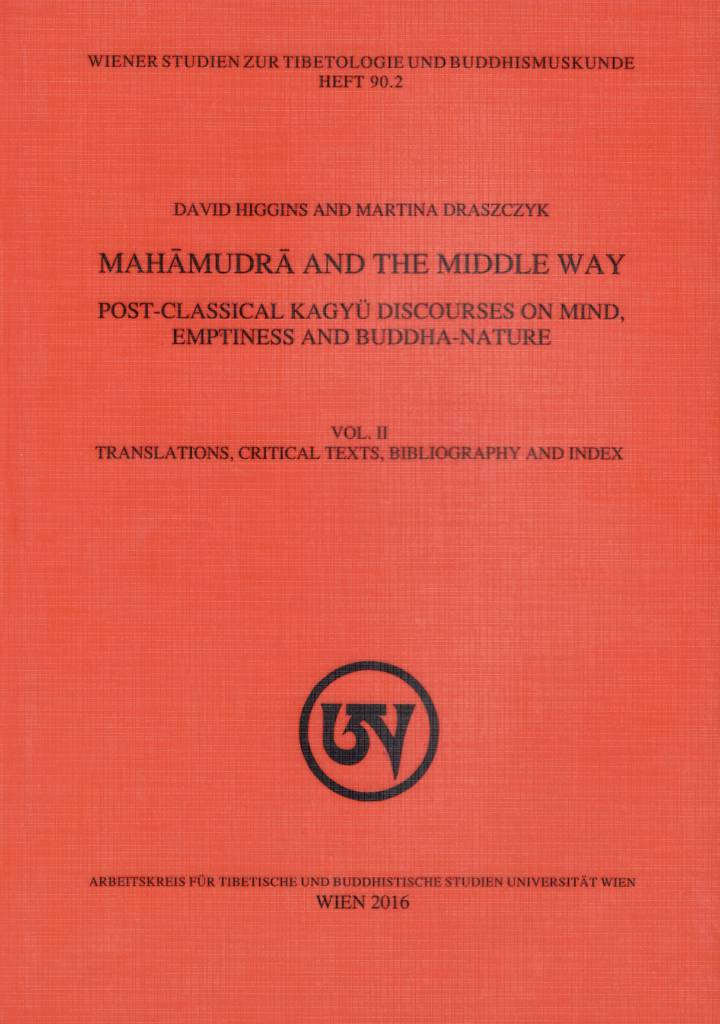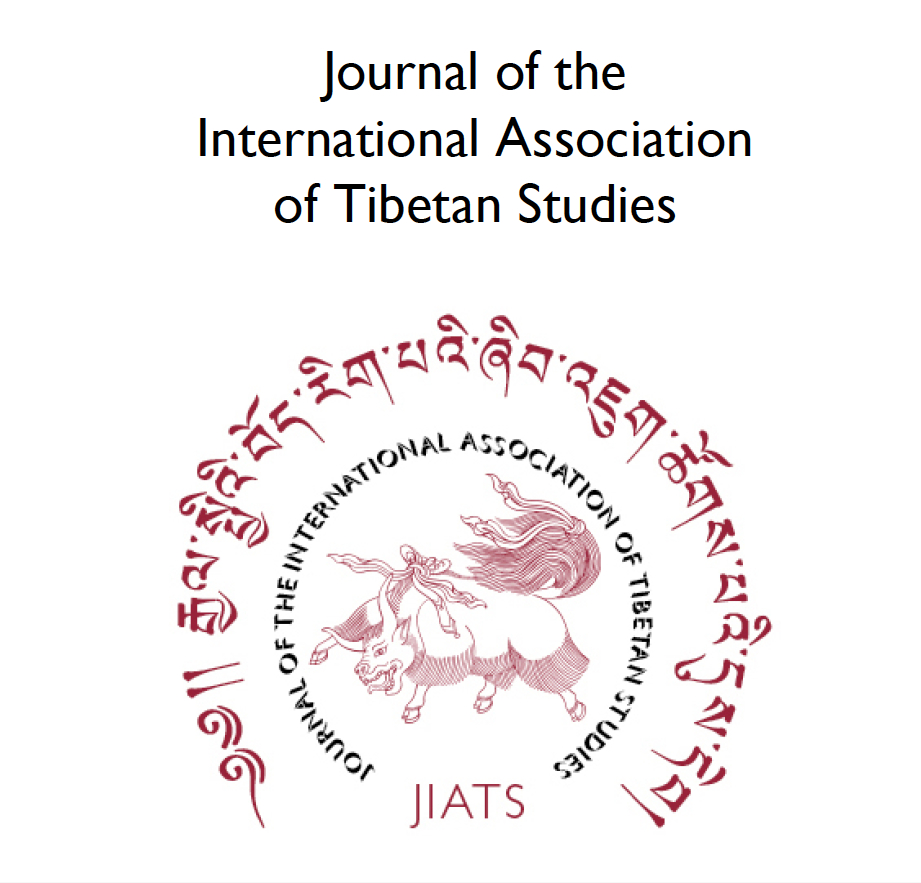Difference between revisions of "Other-Emptiness and the Great Middle Way"
| Line 64: | Line 64: | ||
::<em>If the absolute is pure awareness, that entails unconditioned pure awareness.<br>It also entails permanent and stable pure awareness.<br>It also entails eternal and everlasting pure awareness.<br>It also entails the pure awareness of the sugata essence.<br>It also entails the pure awareness of the nine fully established natures. | ::<em>If the absolute is pure awareness, that entails unconditioned pure awareness.<br>It also entails permanent and stable pure awareness.<br>It also entails eternal and everlasting pure awareness.<br>It also entails the pure awareness of the sugata essence.<br>It also entails the pure awareness of the nine fully established natures. | ||
| − | |Dol po pa shes rab rgyal mtshan. bka' bsdu bzhi pa'i don bstan rtsis chen po. '' | + | |Dol po pa shes rab rgyal mtshan. bka' bsdu bzhi pa'i don bstan rtsis chen po. Paro, Bhutan: Lama Ngodrup and Sherab Drimay, 1984: p. p. 375.<br>- Translation from Stearns, Cyrus. ''The Buddha From Dolpo: A Study of the Life and Thought of the Tibetan Master Dolpopa Sherab Gyaltsen''. Tsadra Foundation Series. Ithaca, NY: Snow Lion Publications, 2010: p. 148. |
| + | |style=max-width: none; | ||
| + | }} | ||
| + | {{Blockquote | ||
| + | |In his Fourth Council, Dölpopa states:</em> | ||
| + | :བདེ་གཤེགས་སྙིང་པོར་གསུངས་པའི་ཀུན་གཞི་དང༌། །ཟག་མེད་དགེ་བར་གསུངས་པའི་ཀུན་གཞི་དང༌། །ས་རྣམས་སྣ་ཚོགས་ཡིན་པའི་ཀུན་གཞི་དང༌། །རང་བཞིན་འོད་གསལ་ཡིན་པའི་ཀུན་གཞི་ནི། །འགྱུར་མེད་ཡོངས་གྲུབ་དབུ་མ་ཆེན་པོ་ དང༌། །མྱང་འདས་ཆེན་པོ་ཕྱག་རྒྱ་ཆེན་པོ་དང༌། །བྱང་ཆུབ་ཆེན་པོ་ཨེ་ཝཾ་མཐར་ཐུག་དང༌། །དུས་འཁོར་མཐར་ཐུག་བདེ་དགྱེས་མཐར་ཐུག་དང༌། །གསང་འདུས་ལ་སོགས་ལྷ་སྔགས་རྒྱུད་ཀུན་དང༌། །དཀྱིལ་འཁོར་མཐར་ཐུག་ལ་སོགས་མཐར་ཐུག་ཀུན། །ཀུན་ནས་འདུས་པ་དུ་མ་རོ་གཅིག་དབྱིངས། །ཤེས་རབ་ཕ་རོལ་ཕྱིན་པའི་མཐའ་ལ་དགོངས། །དེ་ཉིད་དང་པོའི་སངས་རྒྱས་རིས་མེད་དང༌། །གདོད་ནས་གྲོལ་བའི་དེ་བཞིན་གཤེགས་པ་དང༌། །གཙང་བདག་བདེ་དང་རྟག་པའི་འགོག་བདེན་དང༌། །བདེན་དོན་བཅུ་གཉིས་དེ་ཉིད་བཅུ་དྲུག་དང༌། །རྡོ་རྗེ་སེམས་དཔའ་དོན་དམ་བྱང་ཆུབ་སེམས། །འདུས་མ་བྱས་ཀྱི་སྟོང་ཉིད་སྙིང་རྗེ་དང༌། །རྟག་ཅིང་བརྟན་པའི་ཐབས་ཤེས་དབྱེར་མེད་དང༌། །སངས་རྒྱས་ཀུན་བས་སྔར་ སངས་རྒྱས་ཀྱང་ཡིན། | ||
| + | |||
| + | :<em>The universal ground that is taught | ||
| + | to be the sugata essence,<br> | ||
| + | the universal ground that is taught | ||
| + | to be taintless virtue,<br> | ||
| + | the universal ground that is | ||
| + | the various levels,<br> | ||
| + | and the universal ground that is | ||
| + | natural luminosity<br> | ||
| + | refer to the immutable | ||
| + | fully established nature, Great Madhyamaka,<br> | ||
| + | great nirvāṇa, the Great Seal, | ||
| + | great enlightenment, and the ultimate Evaṃ,<br> | ||
| + | all the deities, mantras, and tantras such as | ||
| + | ultimate Kālacakra and ultimate | ||
| + | Cakrasamvara, Hevajra, and Guhyasamāja,<br> | ||
| + | all that is ultimate, such as the ultimate maṇḍalas, | ||
| + | and the basic space where the myriad drawn | ||
| + | together from everywhere has a single taste,<br> | ||
| + | the culmination of the ultimate perfection of wisdom.<br> | ||
| + | |||
| + | Precisely that is the impartial | ||
| + | Primordial Buddha,<br> | ||
| + | the primordially free Tathāgata, | ||
| + | the truth of cessation that is pure, | ||
| + | self, bliss, and permanent,<br> | ||
| + | the twelve aspects of truth, | ||
| + | the sixteen aspects of thatness,<br> | ||
| + | Vajrasattva, absolute enlightenment mind, | ||
| + | unconditioned emptiness and compassion,<br> | ||
| + | permanent and stable method | ||
| + | and wisdom indivisible,<br> | ||
| + | Buddha even before all the buddhas. | ||
| + | |Dol po pa shes rab rgyal mtshan. bka' bsdu bzhi pa'i don bstan rtsis chen po. Paro, Bhutan: Lama Ngodrup and Sherab Drimay, 1984: p. p. 382.<br>- Translation from Stearns, Cyrus. ''The Buddha From Dolpo: A Study of the Life and Thought of the Tibetan Master Dolpopa Sherab Gyaltsen''. Tsadra Foundation Series. Ithaca, NY: Snow Lion Publications, 2010: pp. 157-158. | ||
|style=max-width: none; | |style=max-width: none; | ||
}} | }} | ||
Revision as of 14:54, 15 August 2019
- Karl Brunnhölzl, When the Clouds Part, p. 1018, nt. 532.
Watch & Learn
In English with his direct, characteristic humor, Khenpo Rinpoche presents the "shining star" of buddha-nature in the minds of sentient beings as the same nature as the buddhas. He says, "We are always guided by this nature all the time whether we realize it or not."
Kadam
Tsen Khawoche
In a brief work entitled Instructions on the View of Other-Emptiness that is preserved among the 108 Profound Instructions of the Jonang, Tsen Khawoche describes the three natures as:
- དེས་ན་ཀུན་བརྟག་རང་གི་ངོ་བོས་སྟོང་པ་ཉིད་རི་བོང་གི་རྭ་ལྟ་བུ། གཞན་དབང་ཀུན་བརྟགས་ཀྱིས་སྟོང་པས་སྒྱུ་མ་ལྟ་བུ། ཡོངས་གྲུབ་ཀུན་བརྟག་གཞན་དབང་གཉིས་ཀར་གྱིས་སྟོང་པས་ནམ་མཁའ་ལྟ་བུ། ཀུན་བརྟག་གཞན་དབང་གི་ཐ་སྙད་ཀུན་རྫོབ་ཏུ་ཡོད་ཀྱི་དོན་དམ་དུ་མེད་ལ། ཆོས་ཉིད་ཡོངས་གྲུབ་ནི་དོན་དམ་དུ་ཡོད་ཀྱི། ཆོས་ཅན་ཀུན་རྫོབ་དང་ངོ་བོ་གཅིག་ཐ་དད་གང་ཡང་མ་ཡིན་པ་མཐའ་ཐམས་ཅད་དང་བྲལ་བའི་དབུ་མ་ཆེན་པོའོ།
- In this way, the imaginary nature is devoid of an intrinsic essence, like a hare’s horns. The relational nature is devoid of the imaginary nature, like an illusion. The perfected nature is devoid of both the imaginary nature and the relational nature, like space. Distinctions between the imaginary and the relational are relative, not absolute. The perfected actuality of phenomena is absolute. This is the Great Middle Way, free from extremes without being in any way either identical or different in essence from the phenomenal quality of relative reality.
~ Btsan kha bo che. gzhan stong lta khrid, in zab khrid brgya dang brgyad kyi yi ge, edited by Kun dga' grol mchog. gdams ngag mdzod. New Delhi: Shechen Publications, 1999: Vol. 18, p. 171.
-Translated by Michael Sheehy. Jonang Foundation’s Digital Library
Jonang
Dölpopa Sherab Gyaltsen
As a basic definition, Dölpopa states:
- དེ་ལ་ཀུན་རྫོབ་གློ་བུར་བའི་དངོས་པོ་རྣམས་ནི་གནས་ལུགས་ལ་གཏན་ནས་མེད་པའི་ཕྱིར་རང་གི་ངོ་བོས་སྟོང་སྟེ་དེ་ནི་རང་སྟོང་ངོ་། ཀུན་རྫོབ་དེ་རྣམས་ཀྱིས་སྟོང་པའི་དོན་དམ་སྟོང་པའི་དོན་དམ་གཉུག་མ་ནི་ནམ་ལང་མེད་པ་མ་ཡིན་པའི་ཕྱིར་གཞན་སྟོང་ངོ་།
- Since adventitious, relative entities do not exist at all in reality, they are empty of their own essences; they are self-empty. The innate ultimate, which is the ultimate emptiness of these relative things, is never non-existent; therefore, it is other-empty.
~ Dölpopa Sherab Gyaltsen. Collected Works ('Dzamthang ed., 1998), Vol. 6: 416.
-Translated by Douglas Duckworth in "Onto-theology and Emptiness: The Nature of Buddha-Nature." (2014), page 1075.
In his Fourth Council, Dölpopa states:
- །གལ་ཏེ་དོན་དམ་རིག་པ་ཡིན་ན་ནི།
།འདུས་མ་བྱས་ཀྱི་རིག་པ་ཁུར་ནས་འོང༌།
།རྟག་ཅིང་བརྟན་པའི་རིག་པའང་ཁུར་ནས་འོང༌།
།ཐེར་ཟུག་གཡུང་དྲུང་རིག་པའང་ཁུར་ནས་འོང༌།
།བདེ་གཤེགས་སྙིང་པོ་རིག་པའང་ཁུར་ནས་འོང༌།
།ཡོངས་གྲུབ་དགུ་ཡི་རིག་པའང་དེ་བཞིན་ནོ།
- If the absolute is pure awareness, that entails unconditioned pure awareness.
It also entails permanent and stable pure awareness.
It also entails eternal and everlasting pure awareness.
It also entails the pure awareness of the sugata essence.
It also entails the pure awareness of the nine fully established natures.~ Dol po pa shes rab rgyal mtshan. bka' bsdu bzhi pa'i don bstan rtsis chen po. Paro, Bhutan: Lama Ngodrup and Sherab Drimay, 1984: p. p. 375.
- Translation from Stearns, Cyrus. The Buddha From Dolpo: A Study of the Life and Thought of the Tibetan Master Dolpopa Sherab Gyaltsen. Tsadra Foundation Series. Ithaca, NY: Snow Lion Publications, 2010: p. 148.
In his Fourth Council, Dölpopa states:
- བདེ་གཤེགས་སྙིང་པོར་གསུངས་པའི་ཀུན་གཞི་དང༌། །ཟག་མེད་དགེ་བར་གསུངས་པའི་ཀུན་གཞི་དང༌། །ས་རྣམས་སྣ་ཚོགས་ཡིན་པའི་ཀུན་གཞི་དང༌། །རང་བཞིན་འོད་གསལ་ཡིན་པའི་ཀུན་གཞི་ནི། །འགྱུར་མེད་ཡོངས་གྲུབ་དབུ་མ་ཆེན་པོ་ དང༌། །མྱང་འདས་ཆེན་པོ་ཕྱག་རྒྱ་ཆེན་པོ་དང༌། །བྱང་ཆུབ་ཆེན་པོ་ཨེ་ཝཾ་མཐར་ཐུག་དང༌། །དུས་འཁོར་མཐར་ཐུག་བདེ་དགྱེས་མཐར་ཐུག་དང༌། །གསང་འདུས་ལ་སོགས་ལྷ་སྔགས་རྒྱུད་ཀུན་དང༌། །དཀྱིལ་འཁོར་མཐར་ཐུག་ལ་སོགས་མཐར་ཐུག་ཀུན། །ཀུན་ནས་འདུས་པ་དུ་མ་རོ་གཅིག་དབྱིངས། །ཤེས་རབ་ཕ་རོལ་ཕྱིན་པའི་མཐའ་ལ་དགོངས། །དེ་ཉིད་དང་པོའི་སངས་རྒྱས་རིས་མེད་དང༌། །གདོད་ནས་གྲོལ་བའི་དེ་བཞིན་གཤེགས་པ་དང༌། །གཙང་བདག་བདེ་དང་རྟག་པའི་འགོག་བདེན་དང༌། །བདེན་དོན་བཅུ་གཉིས་དེ་ཉིད་བཅུ་དྲུག་དང༌། །རྡོ་རྗེ་སེམས་དཔའ་དོན་དམ་བྱང་ཆུབ་སེམས། །འདུས་མ་བྱས་ཀྱི་སྟོང་ཉིད་སྙིང་རྗེ་དང༌། །རྟག་ཅིང་བརྟན་པའི་ཐབས་ཤེས་དབྱེར་མེད་དང༌། །སངས་རྒྱས་ཀུན་བས་སྔར་ སངས་རྒྱས་ཀྱང་ཡིན།
- The universal ground that is taught
to be the sugata essence,
the universal ground that is taught to be taintless virtue,
the universal ground that is the various levels,
and the universal ground that is natural luminosity
refer to the immutable fully established nature, Great Madhyamaka,
great nirvāṇa, the Great Seal, great enlightenment, and the ultimate Evaṃ,
all the deities, mantras, and tantras such as ultimate Kālacakra and ultimate Cakrasamvara, Hevajra, and Guhyasamāja,
all that is ultimate, such as the ultimate maṇḍalas, and the basic space where the myriad drawn together from everywhere has a single taste,
the culmination of the ultimate perfection of wisdom.
Precisely that is the impartial Primordial Buddha,
the primordially free Tathāgata, the truth of cessation that is pure, self, bliss, and permanent,
the twelve aspects of truth, the sixteen aspects of thatness,
Vajrasattva, absolute enlightenment mind, unconditioned emptiness and compassion,
permanent and stable method and wisdom indivisible,
Buddha even before all the buddhas.~ Dol po pa shes rab rgyal mtshan. bka' bsdu bzhi pa'i don bstan rtsis chen po. Paro, Bhutan: Lama Ngodrup and Sherab Drimay, 1984: p. p. 382.
- Translation from Stearns, Cyrus. The Buddha From Dolpo: A Study of the Life and Thought of the Tibetan Master Dolpopa Sherab Gyaltsen. Tsadra Foundation Series. Ithaca, NY: Snow Lion Publications, 2010: pp. 157-158.
Tāranātha
In his Essence of Other-Emptiness, Tāranātha states:
- དབུ་མ་ཆེན་པོ་ནི། བོད་དུ་གཞན་སྟོང་དུ་གྲགས་པ་རྣམ་རིག་གི་དབུ་མ་སྟེ། རྗེ་བཙུན་བྱམས་པའི་གཞུང་དང་། འཕགས་པ་ཐོགས་མེད་དང་།མཁས་མཆོག་དབྱིག་གཉེན་གྱིས་གསལ་པར་མཛད་ཅིང་། འཕགས་པ་ཀླུ་སྒྲུབ་ཀྱིས་ཆོས་དབྱིངས་བསྟོད་པར་ཡང་ཆེས་གསལ་བས། འཕགས་མཆོག་གཉིས་ཅར་གྱི་བཞེད་པ་གཞན་སྟོང་ཡིན་ནོ།
- In Tibet, the Great Madhyamaka is the Madhyamaka of discerning cognition and is known as "zhentong." This [system] was elucidated by the treatises of the majestic Maitreya, Asaṅga, the supreme scholar Vasubandhu, and was greatly clarified by Ārya Nāgārjuna’s Dharmadhātustava. In fact, the proclamations of the two most supreme [Asaṅga and Nāgārjuna] is zhentong!
~ TA ra nA tha. gzhan stong snying po. In gsung 'bum/_tA ra nA tha(dpe bsdur ma). Pe cin: krung go'i bod rig pa dpe skrun khang, 2008: Vol. 36, p. 169.
-Tāranātha, Jetsun (2008). The Essence of Zhentong. Translated by Michael Sheehy based upon the ‘Dzam thang edition of the 'Gzhan stong snying po'. Jonang Foundation’s Digital Library: Ngedon Thartuk Translation Initiative.
In his Essence of Other-Emptiness, Tāranātha states:
- །གཞན་སྟོང་གི་གྲུབ་མཐའ་སྤྱི་དེ་ནི། ཕྱོགས་གླང་དང་བློ་གྲོས་བསྟན་པ་ལ་སོགས་པའི་སློབ་མ་སློབ་རྒྱུད་མང་ལ་བཟང་བ་རྣམས་ཀྱིས་རྒྱ་ཆེར་བཤད་ཅིང་། ཐུན་མོང་མ་ཡིན་པ་དེ་ནི་གཞན་གྱི་བློར་ཤོང་བ་དཀའ་ནས་སློབ་མ་མཆོག་རྣམས་ལ་སྙན་ནས་སྙན་དུ་བརྒྱུད་ཚུལ་གྱིས་དར་བར་མཛད་དོ། །ཕྱིས་གཞན་སྟོང་གི་དབུ་མ་འདི་དང་། སེམས་ཙམ་གྱི་གྲུབ་མཐའ་འདྲ་འདྲེས་སུ་བྱས་པ་རྒྱ་གར་དུ་མང་དུ་བྱུང་བ་ལ་བརྟེན་བོད་པ་ཕལ་ཆེར་གྱིས་གཅིག་པར་འཁྲུལ་ལོ། །བོད་དུ་ནི་ལོ་པཎ་དུ་མས་གཞུང་རྣམས་བསྒྱུར་ཀྱང་། གྲུབ་མཐའ་གཙང་མར་འཛིན་པ་ལོ་ཙཱ་བ་གཟུ་དགའ་བའི་རྡོ་རྗེ་དང་། བཙན་ཁ་བོ་ཆེ་སོགས་བྱམས་ཆོས་སྒོམ་ལུགས་པ་རྣམས་ཡིན་ཞིང་། ཁྱད་པར་དུ་གཞན་སྟོང་ཟབ་མོ་སེང་གེའི་སྒྲས་ས་སྟེང་ཁྱབ་པར་མཛད་པ་པོ་ནི། ཀུན་མཁྱེན་ཆེན་པོ་རྡོལ་བུ་ཤེས་རབ་རྒྱལ་མཚན་ཡིན་ནོ།
- As for the general philosophical system of zhentong, this was elaborately explained in the works of Dignāga and Sthiramati as well as by many of their excellent students and successors. As for the extraordinary [philosophical system of zhentong], since this is difficult for most people to comprehend, it was diffused through the manner of whispered ear-to-ear transmission to the most outstanding disciples. Later, there were many in India who confused this Zhentong Madhyamaka with Cittamātra. Relying upon this, most Tibetans perpetuated this same confusion. In Tibet, although there were many scholars who translated these texts, among those who authentically upheld this philosophical system were Lotsāwa Zu Gaway Dorje, Tsen Khawoché, and those of the meditative tradition of the Five Treasures of Maitreya. In particular, the one who made the profound zhentong pervade throughout this land like a lion’s roar was the great omniscient Dolpopa Sherab Gyaltsen.
~ TA ra nA tha. gzhan stong snying po. In gsung 'bum/_tA ra nA tha(dpe bsdur ma). Pe cin: krung go'i bod rig pa dpe skrun khang, 2008: Vol. 36, p. 171.
-Tāranātha, Jetsun (2008). The Essence of Zhentong. Translated by Michael Sheehy based upon the ‘Dzam thang edition of the 'Gzhan stong snying po'. Jonang Foundation’s Digital Library: Ngedon Thartuk Translation Initiative.
Kagyu
Third Karmapa Rangjung Dorje
In his The Treatise on Pointing Out the Tathāgata Heart, the Third Karmapa states:
- །ཐ་མལ་ཤེས་པ་དེ་ཉིད་ལ།
།ཆོས་དབྱིངས་རྒྱལ་བའི་སྙིང་པོ་ཟེར།
།བཟང་དུ་འཕགས་པས་བཏང་བ་མེད།
།ངན་དུ་སེམས་ཅན་གྱིས་མ་བཏང་།
།ཐ་སྙད་དུ་མ་བརྗོད་མོད་ཀྱང།
།རྗོད་པས་དེ་ཡི་དོན་མི་ཤེས།- Just this ordinary mind
Is called "dharmadhātu" and "Heart of the victors."
It is neither to be improved by the noble ones
Nor made worse by sentient beings.
It may no doubt be expressed through many conventional terms,
But its actual reality is not understood through expressions.~ rang byung rdo rje, (Karmapa, 3rd). de bzhin gshegs pa'i snying po bstan pa'i bstan bcos. In gsung 'bum rang byung rdo rje. Zi ling: mtshur phu mkhan po lo yag bkra shis, 2006: Vol. 7, p. 285.
-Translation from Karmapa, The Third, Rang byung rdo rje. Luminous Heart: The Third Karmapa on Consciousness, Wisdom, and Buddha Nature. Translated by Karl Brunnhölzl. Nitartha Institute Series. Ithaca, NY: Snow Lion Publications, 2009: pp. 354-355.
Sakya
Śākya Chokden
In his Undermining the Haughtiness of Others by the Wheel of Brahma: A Treatise Clarifying Mahāmudrā Śākya Chokden states:
- དཔེར་མཚོན་ན། །འཁོར་ལོ་བར་པ་ཆོས་མམས་ཀུན། །རང་སྟོང་ཉིད་དུ་བཤད་འོག་ཏུ། །འཁོར་ལོ་གསུམ་པར་དེས་སྟོང་པའི། །འགྱུར་བ་མེད་པའི་ཡོངས་གྲུབ་ཉིད། །ངེས་པའི་དོན་དུ་བཤད་དེ་བཞིན། །གཞན་ཡང་ཆུ་ཤིང་སྙིང་པོ་ནི། །རྩལ་བས་མ་མྱེད་གྱུར་མོད་ཀྱང་། །ལོ་འདབ་རྒྱས་པའི་དབུས་ཞིག་ཏུ། །འབྲས་བུ་མངར་པོར་སྨིན་དེ་བཞིན༎
- To illustrate with an example, [the Buddha]—after explaining in the middle dharmacakra that all phenomena are simply empty of own-nature—taught in the third dharmacakra that the unchanging perfect nature which is empty of that [self-emptiness] is the definitive meaning. Likewise, one doesn’t find any core of a banana plant when one searches for it, yet in the middle of the unfolded leaves [bananas] nonetheless ripen as sweet fruits.
~ shAkya mchog ldan. phyag rgya chen po gsal bar byed pa'i bstan bcos tshangs pa'i 'khor los gzhan blo'i dregs pa nyams byed. In gser mdog paN chen shAkya mchog ldan gyi gsung 'bum. rdzong sar: rdzong sar khams bye'i slob gling thub bstan dar rgyas gling, 2006-2007: Vol. 17, p. 368.
-Higgins, David and Martina Draszczyk. Mahāmudrā and the Middle Way: Post-Classical Kagyü Discourses on Mind, Emptiness and Buddha-Nature. Volume 2: Translations, Critical Texts, Bibliography and Index. Wiener Studien zur Tibetologie und Buddhismuskunde 90. Vienna: Arbeitskreis für Tibetische und Buddhistische Studien Universität Wien, 2016: p. 21.
Nyingma
Mipam Gyamtso
In his Lion's Roar Affirming Other Emptiness, Mipam states:
- གཞན་སྟོང་གི་གྲུབ་མཐའ་ངེས་པར་གཏན་ལ་འབེབ་ན། དང་པོ་མགོན་པོ་ཀླུ་སྒྲུབ་ཀྱི་གཞུང་བཞིན་དུ་ཆོས་ཐམས་ཅད་རང་བཞིན་མེད་པར་གཏན་ལ་འབེབས་དགོས་ཏེ། དེ་མ་ཤེས་ན་ཀུན་རྫོབ་རང་ངོ་ནས་སྟོང་ཚུལ་དང་། དོན་དམ་གཞན་གྱིས་སྟོང་ཚུལ་གཏན་ལ་མི་ཕེབ་པས། ཐོག་མར་སྤྲོས་བྲལ་སོ་སོར་རང་གིས་རིག་པར་བྱ་བའི་དོན་གཏན་ལ་དབབ་པར་བྱའོ།
- In order to understand definitively the philosophical system of extrinsic emptiness, one must first understand the absence of inherent existence according to the texts of Nāgārjuna. If one does not understand this, one will not understand how deceptive reality is empty with respect to itself, and how ultimate reality is empty with respect to the other. So, one must first understand for oneself the absence of conceptual elaborations.
~ Mi pham rgya mtsho. gzhan stong khas len seng ge'i nga ro. View Tibetan text on Adarsha
-Translation from Pettit, John W, and Mi pham rgya mtsho. Mipham's Beacon of Certainty: Illuminating the View of Dzogchen, the Great Perfection. Boston: Wisdom Publications, 1999: p. 415.
In his Lion's Roar Affirming Other Emptiness, Mipam states:
- །ངེད་ཀྱི་ལུགས་ལ་ཡུལ་སྟོང་པ་ཉིད་དང་། ཡུལ་ཅན་ཡེ་ཤེས་གཉིས་ཀ་དོན་དམ་ཡིན་ཅིང་། དེ་གཉིས་ཡང་དག་པའི་དོན་དུ་སྣང་སྟོང་བདེན་གཉིས་ཐ་དད་མེད་པས་དོན་དམ་པའི་ཆོས་ཀྱི་དབྱིངས་ནི་སྟོང་པ་ཕྱང་ཆད་མ་ཡིན་ཏེ། རྣམ་དབྱེར་མེད་པའི་སྐུ་དང་ཡེ་ཤེས་ཀྱིས་མི་སྟོང་པར་ཡེ་ནས་ལྷུན་གྱིས་གྲུབ་པའི་ངོ་བོ་ཉིད་ཀྱི་སྐུར་གནས་སོ།
- In our system, both objective emptiness and the subject, which is gnosis, are ultimate. In the final analysis, both of these are the nondifference of the two truths of appearance and emptiness, so the ultimate expanse of phenomena is not an ascertained emptiness. It is not empty of the inseparable Buddha bodies and gnoses, and abides as the primordial, spontaneously present essence body (ngo bo nyid sku, svabhākāya).
~ Mi pham rgya mtsho. gzhan stong khas len seng ge'i nga ro. View Tibetan text on Adarsha
-Translation from Pettit, John W, and Mi pham rgya mtsho. Mipham's Beacon of Certainty: Illuminating the View of Dzogchen, the Great Perfection. Boston: Wisdom Publications, 1999: p. 421.
Further Readings
[The Buddha from Dolpo (2010)]
Little is known about the early Tibetan proponents of philosophical points of view that would later come to be known as shentong. According to Lhai Gyaltsen, many persons with partial realization of the teachings of definitive meaning had appeared in Tibet before the fourteenth century, most of them dedicated practitioners. But no one until Dölpopa had mastered all the teachings of definitive meaning in the various scriptures, treatises, and esoteric instructions, and then formulated that realization into a coherent philosophical tenet. Tāranātha traces one lineage for what he calls "instructions on the view of the Madhyamaka emptiness of other," and a second lineage for the Kālacakra teachings passed down in the Jonang tradition. [...] This first text is a record of the names of teachers who taught the shentong view based on the teachings of the Mahāyāna scriptures and commentaries. Jetsun Tāranātha's second text, concerned with the lineage of the Kālacakra teachings transmitted in the Jonang tradition, records the names of teachers who taught the shentong view based on the tantras, specifically as articulated in the Kālacakra Tantra and related literature. Examples of the writings of very few of the Tibetan masters in each of these lineages before the time of Dölpopa seem to have survived.
[When the Clouds Part]
In its chapter on how the Shentong tradition spread in India and Tibet, as mentioned above, the [Treasury of Knowledge] states that the intention of the sūtras of the third wheel of dharma was elucidated by the works of Maitreya except the Abhisamayālaṃkāra and by Nāgārjuna’s collection of praises. In India, the meaning of these texts was explained and spread widely by Asaṅga, Vasubandhu, Candragomī, their followers, Ratnākaraśānti, and others. Dharmapāla (530-561) composed a treatise called Dawn of Brightness commenting on Nāgārjuna’s collection of reasoning as bearing the intention of the third wheel of dharma. However, while the general philosophical system of Maitreya as expressed in the Abhisamayālaṃkāra, Mahāyānasūtrālaṃkāra, and Madhyāntavibhāga was explained through many traditions (such as those of Dignāga and Sthiramati), the uncommon view of these texts was sustained in such a way that only the supreme disciples transmitted it orally, with the texts of the Dharmadharmatāvibhāga and Uttaratantra being hidden away as treasure texts until Maitrīpa rediscovered them. Via *Ānandakīrti and Sajjana, these texts were transmitted to Ngog Lotsāwa as well as Su Gawé Dorje and Dsen Kawoché.
[Mahāmudrā and the Middle Way]
This two-volume publication explores the complex philosophy of Mahāmudrā that developed in Tibetan Dwags po Bka’ brgyud traditions between the 15th and 16th centuries CE. It examines the attempts to articulate and defend Bka’ brgyud views and practices by four leading post-classical thinkers: (1) Shākya mchog ldan (1423‒1507), a celebrated yet controversial Sa skya scholar who developed a strong affiliation with the Karma Bka’ brgyud Mahāmudrā tradition in the last half of his life, (2) Karma phrin las Phyogs las rnam rgyal (1456‒1539), a renowned Karma Bka’ brgyud scholar-yogin and tutor to the Eighth Karma pa, (3) the Eighth Karma pa himself, Mi bskyod rdo rje (1507‒1554), who was among the most erudite and influential scholar-hierarchs of his generation, (4) and Padma dkar po (1527‒1592), Fourth ’Brug chen of the ’Brug pa Bka’ brgyud lineage who is generally acknowledged as its greatest scholar and systematizer.
[[|Book: Buddha Nature Reconsidered]]
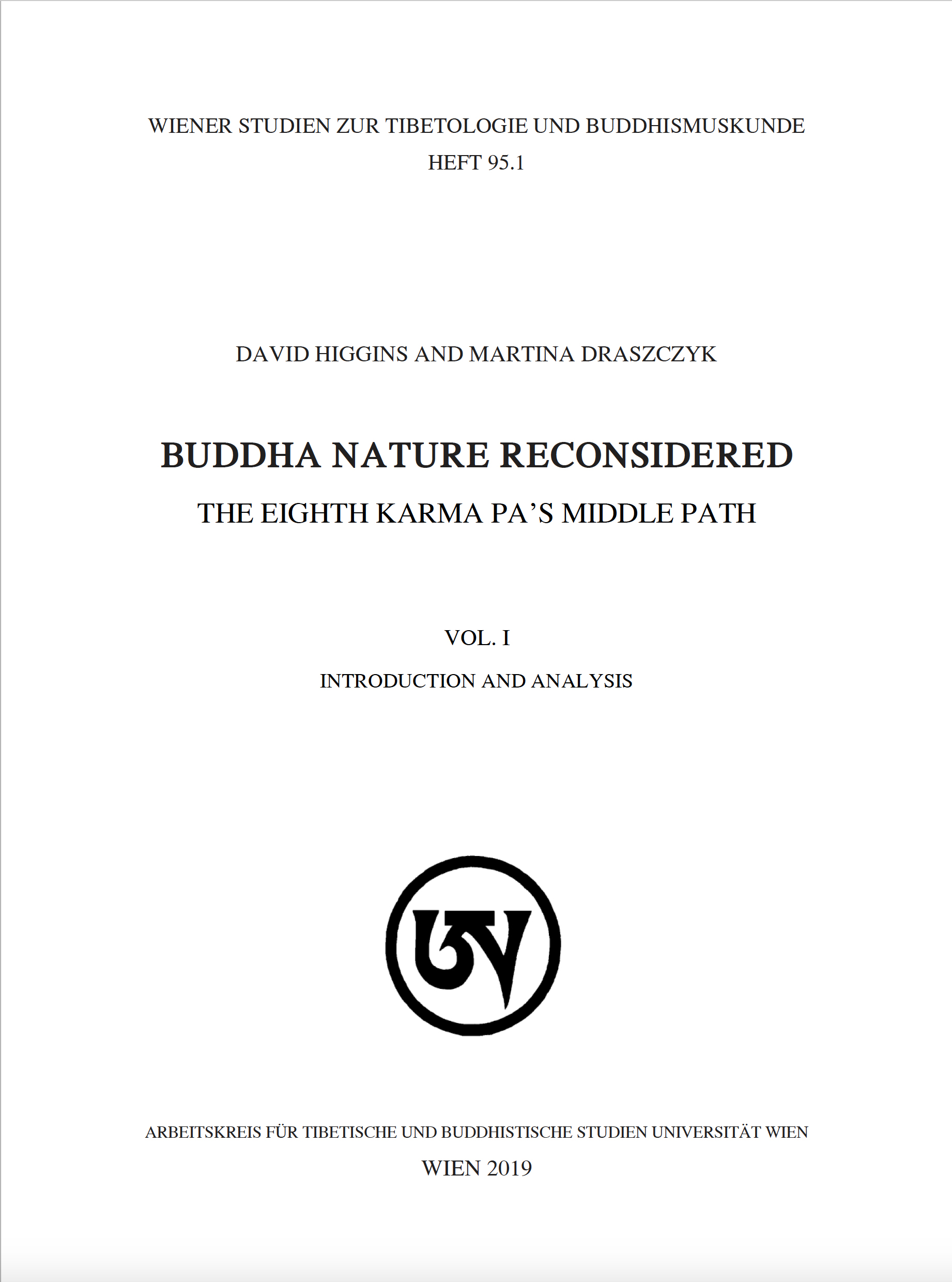
As a Mahāmudrā proponent, Mi bskyod rdo rje gives primacy to innate modes of being and awareness, such as coemergent wisdom or buddha nature naturally endowed with qualities, that are amenable only to direct yogic perception and revealed through the personal guidance of a qualified teacher. As an exponent of yuganaddha (zung ’jug), i.e., unity (literally, “yoking together”), he espouses the tantric goal of unity beyond extremes, a goal grounded in the inseparability of the two truths or realities (bden gnyis dbyer med), of appearance and emptiness (snang stong dbyer med). In his eyes, this unity is only fully realized when one understands that the conventional has no independent existence apart from the ultimate and that the latter is a condition of possibility of the former. As an advocate of apratiṣṭhāna (rab tu mi gnas pa), i.e., nonfoundationalism, he resolutely maintains that all outer and inner phenomena, including deep features of reality disclosed through meditation, lack any ontic or epistemic essence or foundation that the mind can lay hold of. Finally, as a champion of Madhyamaka, i.e., the Buddhist Middle Way, the author attempts to ply a middle course between the extremes of existence and nonexistence, eternalism and nihilism. These various doxographical strands are deftly interwoven in the Karma pa’s view of buddha nature, which affirms the innate presence of buddha nature and its qualities in all sentient beings as well as their soteriological efficacy while denying either any ontological status.
[The Nyingma School of Tibetan Buddhism]
Concerning the subtle, inner Great Madhyamaka of definitive meaning, it is stated in the Jewel Lamp of the Madhyamaka by the master Bhavya (skal-ldan):
The Madhyamaka of the Prāsaṅgika and the Svātantrika is the coarse, Outer Madhyamaka. It should indeed be expressed by those who profess well-informed intelligence during debates with [extremist] Outsiders, during the composition of great treatises, and while establishing texts which concern supreme reasoning. However, when the subtle, inner Madhyamaka is experientially cultivated, one should meditate on the nature of Yogācāra-Madhyamaka.
In this way, two Madhyamaka are spoken of, one outer and coarse, the other inner and subtle.
Concerning the latter, the regent Ajita [Maitreya] has extensively analysed the meaningful intention of the topics of vast significance which revealed all things in terms of the three essential natures. This he did by means of discourses connected with the irreversible intention of the final turning of the doctrinal wheel and with the utter purity of the three spheres [of subject, object and their interaction].
[[|Book: The Gzhan stong Chen mo]]

Over seven hundred years after Dol po pa's interpretive formula and philosophical articulation known as "gzhan stong"—regarding how the nature of relative reality empty of intrinsic characteristics while ultimately full of enlightened qualities—these writings as well as the larger body of Jo nang gzhan stong literature have received little attention within the Western academy. Due to the historical accident of privileged access to diasporaic Tibetan traditions emphasizing "rang stong"—in contrast to "gzhan stong"—a premature normative has been set within Western studies on Tibetan Buddhist interpretations of emptiness, resulting in the gzhan stong formulation of the Jo nang tradition being less well-known. However, due to more recent access to the living Jo nang Tibetan Buddhist tradition in the Amdo region of the northwestern cultural domain of Tibet, and due to more regular availability of gzhan stong literature, we now have opportunities to re-consider this normative and re-evaluate the gzhan stong understanding of the Jo nang.
[[|Article: Did ’Gos lo tsā ba gZhon nu dpal (1392–1481) Espouse a gZhan stong View?]]

The article investigates ʼGos Lo tsā ba gZhon nu dpalʼs analysis of Buddha nature and pursues the question of whether this master advocated a gzhan stong view. Mathes faces a difficult situation regarding sources, since no philosophical work by ʼGos Lo tsā ba has come down to us apart from a commentary on the Ratnagotravibhāga (in which the term gzhan stong is not mentioned). Therefore, Mathes makes use of “secondary sources” such as the Eighth Karma paʼs polemical review of ʼGos Lo tsā baʼs lost Kālacakra commentary and a biography composed by the Fourth Zhwa dmar pa. As Mathes is able to show, ʼGos Lo tsā baʼs position on Buddha nature differs sharply from the position held by the Eighth Karma pa, who (like the Third and Seventh Karma pas) supported a type of gzhan stong view. It is, moreover, obvious that ʼGos Lo tsā ba was influenced, to a certain extent, by Tsong kha paʼs scholastic exegesis and thus attempted to harmonize the latterʼs view of emptiness with the mahāmudrā approach of the bKaʼ brgyud pas. In the end, Mathes comes to the conclusion that it is problematic to describe ʼGos Lo tsā baʼs position as gzhan stong, although the Eighth Karma pa (ironically) terms it as “great gzhan stong.”
[A Look at the Diversity of the Gzhan stong Tradition]
This article introduces two studies by classical Tibetan Buddhist scholars that explain the range of meanings of the term zhentong. The two texts – one by Pema Bidza (twentieth century), the other by Tāranātha (1575-1634) – are analytical studies that summarize and compare the various views of previous scholars who wrote on zhentong. Such interpretive studies are valuable in that they present us with different ways of interpreting the heterogeneous material classified under the rubric “zhentong.” They also suggest ways of contextualizing the different levels of discourse found within this material.
